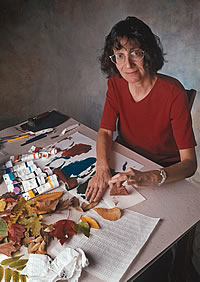|
Issue Contents :: The Last Word
Never Too Late
by Barbara Cohn ’71
Finding solace through artistic creation
 I contracted multiple sclerosis in 1994, many years after graduating from Oberlin with a degree in art history. When told I had MS, I reacted with panic: it seemed to mean a life of disability. At age 49, I found it difficult to accept hav-ing an incurable disease after living such a healthy life. Fortunately, as I soon learned, there are effective treatments to help manage the disease. I contracted multiple sclerosis in 1994, many years after graduating from Oberlin with a degree in art history. When told I had MS, I reacted with panic: it seemed to mean a life of disability. At age 49, I found it difficult to accept hav-ing an incurable disease after living such a healthy life. Fortunately, as I soon learned, there are effective treatments to help manage the disease.
My neurologist treated me with Avonex, a drug developed by Western medicine
to help control the spread of lesions. I receive a weekly injection, but I have never felt it to be enough. I sought out acupuncture to help with such symptoms as numbness in the extremities, garbled speech, and loss of balance that has led to several falls and a hip fracture. I have had hand rails installed on all the stairs in my house; where there are no rails, I walk with trepidation.
In spite of my MS, I have had a calling that makes me feel whole, complete, and healthy. Namely, work as a visual artist.
I hadn’t known what I would do with my art history major until I was diagnosed with MS. I had simply enjoyed the study of art, learning to see shapes, colors, and lines and how they interrelate.
My appreciation for art came early in life. My parents were art collectors who would take occasional trips to New York City to meet artists of interest. Our house was teeming with the likes of Louise Nevelson, Milton Avery, and Ben Shahn. My mother was a docent at the National Museum of American Art for 20 years, and she made ceramic bowls and knitted.
Years later, I landed a job as editor of a quarterly 12-page publication for the Washington chapter of the Artists Equity Association, a non-profit whose main purpose is to help members sell their work through group shows. For 10 years, I conducted interviews with artists and gallery and museum owners and wrote book reviews on art-related subjects. But I never had an interest in creating art myself. I had no idea how to start. As a child, I was a lousy drawer. Art was for the Picassos of this world, not for me.
My life changed one day when an acquaintance of mine,
an established artist, mentioned that she wanted to show me something in her studio. After weeks of procrastination, I gave in. I stepped into her studio to find an assortment of leaves on her working table, along with a selection of acrylic paints and brushes.
My friend explained by demonstration: “Choose a leaf. Choose some paint. Apply the paint to the underside of the leaf and press it onto a piece of paper.”
I followed along, and soon began to feel like an artist. It occurred to me that the possibilities were limitless: How many colors were available? How many leaves were available? How many ways could a leaf be cut? And how about overlapping the leaves? I returned to her studio several more times for lessons.
Soon afterward, I took new notice of the ivy growing in my backyard. Because of its deep veins, ivy makes a definitive impression on paper. After exhausting my own ivy territory I started buying plants from a florist.
Creating art was a joy that I never thought would come to me. I began sending framed monoprints to whomever I thought would enjoy them—friends and family in Texas, Illinois, Colorado, Washington, and California. Everyone gave appreciative feedback.
I then asked my artist friend about my next step. It was, to my horror, a drawing class. I got over that fear and ended up taking three of them. I then had a try at oil painting. When that class ended, I was on my own. I got my studio together with brushes, canvas boards, oils, and paint thinner. The local art supply store now knows me well.
Today, painting is a challenge I enjoy. Each flower I paint is unique. I discern its shape, size, and color. Color is an exploration of the rainbow; an ongoing juggling of colors maximizes the impact of the final product. When I’ve hit the mark, I feel my painting sing.
I’ve had many flops, but I’ve made at least two paintings that make me proud. There are occasional setbacks in my art, but I’m always able to rebound with a healthy addiction.
My last three MRIs, done in 1994, 1999, and 2004, showed no further lesions.
It continues to amaze me that even with an incurable disease I can be so content. I often feel that MS is a trade-off, something to embrace. It has made me emotionally stronger and able to cherish my loving husband. It has made me value my recently discovered talent as an artist. In spite of my disability, I have created a life that is nurturing to others and myself. When I feel troubled, my artwork gives me solace.
Barbara Cohn lives in Chevy Chase, Maryland.
|





